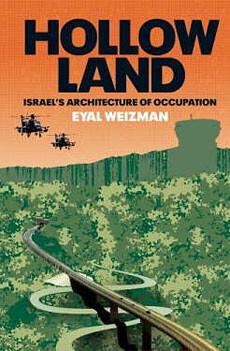The Electronic Intifada 23 January 2008

Last year, I experienced at first hand Israel’s new-look occupation. Intending to cross into Israel from the northern West Bank, I arrived at the Jalama checkpoint expecting the usual token passport check. Instead, I was told that it was forbidden for me to use this particular crossing point. For six hours I sat under the watchful eye of two soldiers, making calls to the British consulate, which, in turn, called various Israeli military officials.
During my extended visit, I had plenty of time to observe my surroundings. One of the new “terminals” that Israel has built, Jalama is on the “Green Line,” but there are others that lie well inside the Occupied Palestinian Territories (OPT). These new checkpoints are built like international borders, with metal detectors, turnstiles, winding passages and the disembodied voices of security personnel.
The occupation’s architecture has undergone a number of fundamental changes in recent years. The entrance to Bethlehem is now marked by a terminal, a towering concrete wall and an Israeli sign that reads “Peace be with you.” Palestinians traveling within the West Bank now pass through the equally substantial Qalandiya terminal. East Jerusalem, meanwhile, is divided by the contorted loops of the Separation Wall.
This architecture of occupation is thoroughly analyzed in the Israeli-born architect Eyal Weizman’s Hollow Land. The study takes us to the heart of a conflict which has always been about land, where “the mundane elements of planning and architecture have become tactical tools and the means of dispossession.” Behind the headlines, the reality on the ground (as well as above and beneath it) continues to be reshaped daily.
Many new arrivals and even resident Israelis are unable to see where Israel proper ends and where the occupation begins. This is especially true in occupied East Jerusalem, where the architecture of the annexed settlements has been used to “blur the facts of occupation.” It is also true for other settlement blocs that often serve as commuter towns for cities such as Tel Aviv.
Much of the occupation’s architecture is a message to the Palestinians. Once, viewing the West Bank colonies, Ariel Sharon remarked that “Arabs should see Jewish lights every night from 500 meters.” Indeed, from Bethlehem’s restaurants, the view is of the ever-expanding Har Homa settlement, while Palestinian farmers across the West Bank look up from their valleys at the red-roofed houses on the hilltops above.
One of the photographs in Hollow Land is especially striking. At the Allenby Bridge crossing between Jordan and the West Bank, Palestinians wait in line for their papers to be checked by Palestinian Authority policemen. Behind a two-way mirror, however, Israeli agents are at work, vetting every traveler. With this sovereignty charade central to the Oslo peace process, occupation infrastructure replaced “the necessity for the physical presence of Israeli forces within Palestinian cities.” Israel can appear to be ceding territory generously while “still dominating the Palestinians physically, collectively and politically by remotely controlling their movements.”
Back at the Jalama checkpoint, weary Palestinian men passed through as I waited, returning from work inside Israel. The new aspects of the occupation’s infrastructure are often defended as examples of Israel’s “humanitarian” concern despite the country’s security dilemma; Weizman, however, notes that “the ‘humanitarian’ rhetoric of the current phase of the occupation is part of a general attempt to normalize it.” In fact, “cases of colonial powers seeking to justify themselves with the rhetoric of improvement, civility and reform are almost the constant of colonial history,” he argues.
Inevitably, the architects themselves end up under the spotlight. The question of their complicity and moral responsibility is a controversial one. Weizman, like the members of Architects and Planners for Justice in Palestine, believes that those “design and construction professionals involved in projects that appropriate land and natural resources from Palestinian territory” are “complicit in social, political and economic oppression,” in “violation of their professional ethics.”
Critics of this position complain that Israel is being singled out unfairly, that such a campaign “politicizes” a technical profession, and that the situation is too complex for “simplistic” blame to be apportioned. The Israel Association of United Architects, for example, claims it is “not for professional associations to weigh in to political debates” and that the decision by some Israeli architects to accept commissions in the OPT is “a matter of personal conscience.”
While constructing the occupation’s infrastructure constitutes an obviously political act, describing it as such apparently amounts to unacceptable politicization – as does pointing out its consequences for the Palestinians. That’s according to Daniel Leon, chairman of British Architect Friends of Israel, who, in a letter to The Financial Times in August, commended an alternative approach of “mutual understanding through dialogue” more befitting the “complicated” political and physical realities.
In its detailed breakdown of the three-dimensional occupation, and faithfulness to the reality in Palestine/Israel, Hollow Land in fact suggests that ultimately, all the construction in the OPT – the bridges, tunnels, terminals, roads, colonies and walls – will be in vain:
At a time when “separation” between Israelis and Palestinians seems to be the only game in town, experiencing and analyzing the architecture of occupation suggests that equitable, sustainable partition may be an impossible task.
Ben White is a freelance journalist specializing in Palestine/Israel. His website is at www.benwhite.org.uk and he can be contacted directly at ben@benwhite.org.uk. This article was originally published by The New Statesman and is republished with the author’s permission.
Related Links





